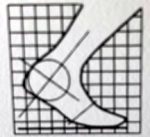A tailors bunion is a common condition of the foot that often leads to discomfort and pain when wearing shoes. The condition is frequently progressive and becomes worse with time.
The Tailors bunion is a bony prominence at the base of the fifth toe (little toe). Anatomically the toes are connected to long bones in the mid-foot called metatarsal bones. The tailors bunion is a prominence or enlargement of the head of the fifth metatarsal.
The cause of the tailors bunion is abnormal movements of joints in the rear portion of the foot that results in flattening, widening or splaying for the foot. Contributing factors to the abnormal movements of these joints in the foot are excessive tightness of the calf muscle that restricts adequate motion in the ankle and a difference in the length of the legs. Certain shoe styles also may contribute to symptoms of tailors bunions but do not cause them to develop. If the shape of the shoe is curved inward at the forefoot area it will cause excessive pressure on the outside portion of the foot and irritate an existing tailors bunion. The limitation of ankle movement caused by tight calf muscles contributes to the foot flattening, widening and splaying. If one leg is longer than the other leg the foot is also forced to widen or splay. As the deformity progresses and worsens shoe pressure may cause a secondary bursa and/or irritation of a skin nerve in the area. This may occur with any shape of style of shoe.
Tailors bunions may present as an isolated foot problem. However, they frequently present with other foot abnormalities such as hammertoes and bunions.
Diagnosis:
The diagnosis of a tailors bunion is made by your doctor follow a history of your complaint, a physical exam and x-rays.
If a bursa is present the physical exam will reveal a soft moveable swelling over the area. This swelling will cause the tailors bunion to appear larger than the actual bony prominence. Should the nerve be inflamed and contributing to the pain the physical exam will demonstrate a “tingling” when the area is lightly tapped with the tip of a finger.
Treatment:
Treatment suggestions are based upon the results of the doctor’s findings. These suggestions take into consideration the overall health status of the patient, the level of pain and discomfort, any limitations of activity or the ability to wear normal shoes comfortably. They also take into consideration the normal daily activities of the patient, the type of work one performs, the required or desired shoes one wants to wear and the desired or expected results the patient seeks.
Treatment suggestions may include any of the following or a combination of them.
A recommendation in the style of shoes worn. This does not imply bigger shoes or the avoidance of high heels or dresses shoes.
Padding of the area to reduce shoe pressure. Gel pads are often very useful.
Topical gels or creams to sooth the inflamed area such as Biofreeze.
Over the counter insoles
Custom inserts for the shoes called orthotics that control abnormal movements in the joints of the feet.
Calf stretching exercises
Cortisone injections and/or oral anti-inflammatory medications to treat the inflammation of a bursa or inflamed nerve
Surgical correction to remove the bony prominence or realign the fifth metatarsal bone
In acutely painful situations the doctor may suggest an open toed shoe, protective shoe or cast boot temporarily
Tailors bunions are a common foot abnormality that can result in pain and the limitation of activity. It is easily diagnosed and treated successfully.
